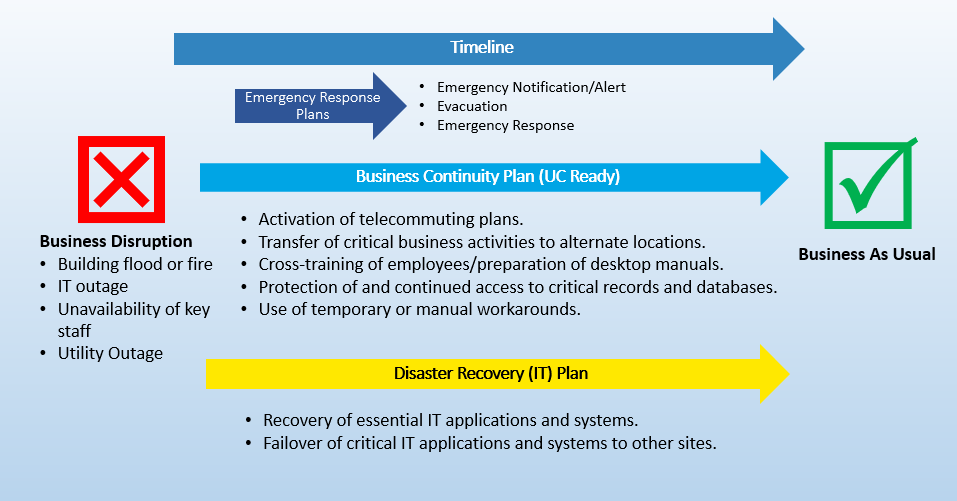Overview
Past unexpected events on the campus such as floods, fires, and damaged server rooms, resulted in departments relocating operations, halting services, or suffering permanent data loss. Business continuity is our preparation for these and other unexpected disruptions to continue to provide our essential services with as little disruption as possible.
- Key Business Continuity terms
- UC Ready Web Demo
- Business Continuity Brochure
-Business Continuity Toolkit
-Sample Business Continuity Plan
Business continuity is different from emergency management. Emergency management secures life and safety in response to a disaster or emergency. A business continuity plan is used once life and safety are secure and is used to help you to continue your operations. These plans also work with IT disaster recovery plans which are plans and procedures to restore IT services (e.g. applications and infrastructure) as part of the overall campus business continuity plan.

UC Ready is an online tool that is being implemented throughout the University of California System (10 campuses; 5 medical centers) to store and create business continuity plans. Additionally, IT Disaster Recovery templates have been made available to recover IT applications and services.
UC Ready Quick Start Guide:https://ucla.box.com/v/irm-Quickstart-UCReadyUC Ready Manual:https://ucla.box.com/v/irm-UCReady-Manual
UC Ready Planning Tool (contact IRM for access):https://ucready-fusion.cloudforce.com/
As a manager for your department, determine who will coordinate the planning process for your department and contact Tara Brown, Business Continuity Planner, to set up an introductory meeting. As a staff member, you have valuable insight into the operations of your department and in the future might serve on a planning team to assist with creating plans.
The breadth and depth of your department’s operations will determine the level of detail required by your continuity plans. Low impact units may only need a few details and high impact units will require more information and resources.
See this worksheet for full details on campus enterprise planning versus department planning: https://ucla.box.com/v/irm-bc-enterprise-v-department
There are three steps to creating a continuity plan:
- Identify priorities:As part of the business impact analysis (BIA), we want to know what parts of the University must be recovered first, how long a disruption can be sustained, and what could happen as a result (impacts). For more information on this step:https://ucla.box.com/v/irm-bc-step-1- Identify strategies: After identifying your department’s essential operations, we look at ways to continue to operate after a disruption. This may include telecommuting, reciprocal agreements, cross-training staff, using manual workarounds, and more. For more information on this step:https://ucla.box.com/v/irm-step2
- Create plans:Plans will document information gathered in the first two steps and will be a reference guide should you need to continue or recover your department’s operations. For more information on this step: https://ucla.box.com/v/irm-bc-step3
- Quarterly business continuity town hall meetings: We also hold quarterly town hall meetings for all campus business continuity coordinators to discuss best practices in business continuity planning and lessons learned. Please contact Tara Brown to participate.
